Did you know many backyard birds in the United States eat butterflies? Birds like warblers, sparrows, and robins help keep butterfly numbers in check. This balance is key to a healthy ecosystem.
Butterflies, like the Monarch, have ways to avoid birds. Yet, most butterflies are still at risk from birds. Learning about this relationship helps us understand our local wildlife better.
Key Takeaways:
- Many common backyard birds, including warblers, sparrows, flycatchers, robins, thrushes, and wrens, regularly consume butterflies as part of their diet.
- Bird predation on butterflies plays a vital role in maintaining the balance of butterfly populations and contributing to a healthy, diverse ecosystem.
- Some butterfly species, like the Monarch, have developed defense mechanisms to deter avian predators, but the majority of butterflies remain vulnerable to bird consumption.
- Understanding the predator-prey relationship between birds and butterflies is essential for appreciating the complex web of life in our local environments.
- Maintaining a balance between bird and butterfly populations is crucial for the overall health and biodiversity of an ecosystem.
Understanding Bird Predation of Butterflies
The relationship between birds and butterflies is key to the ecosystem balance. Birds hunt and eat different butterfly species. This interaction is interesting for nature observation and bird watching.
Natural Predator-Prey Relationships
Warblers, orioles, and flycatchers hunt adult butterflies and their young. Birds like praying mantises and dragonflies also eat butterflies. Even ladybugs and toads in backyards eat butterflies and their young.
Role in Ecosystem Balance
Birds help keep the ecosystem balance by controlling butterfly numbers. This keeps butterfly populations healthy and diverse. It supports the whole ecosystem.
Seasonal Feeding Patterns
Birds’ eating habits change with the seasons and what’s available. Some birds hunt butterflies more when it’s cold and food is hard to find. Others change their hunting based on butterfly migrations.
“Birds play a crucial role in regulating the populations of butterflies, which can have far-reaching consequences for the overall health and diversity of the ecosystem.”
Common Backyard Birds That Hunt Butterflies
Many backyard birds are known to hunt butterflies. This shows how connected our ecosystem is. These birds help keep butterfly numbers in check.
Warblers are quick flyers that catch butterflies in the air. Sparrows eat both butterflies and their young, helping control butterfly numbers.
Flycatchers are good at catching flying insects, including butterflies. Robins and thrushes, mostly worm-eaters, sometimes eat butterflies too. This adds to their varied diet.
Wrens, though small, are fierce hunters. They eat butterflies, showing many birds hunt butterflies.
| Backyard Bird | Feeding Habits |
|---|---|
| Warblers | Catch butterflies in mid-air |
| Sparrows | Feed on both butterflies and caterpillars |
| Flycatchers | Adept at catching flying insects, including butterflies |
| Robins and Thrushes | Primarily feed on worms and insects, but may occasionally eat butterflies |
| Wrens | Small insectivorous birds that include butterflies in their diverse diet |
These birds show how important bird watching is. They help keep butterfly numbers balanced in our neighborhoods.
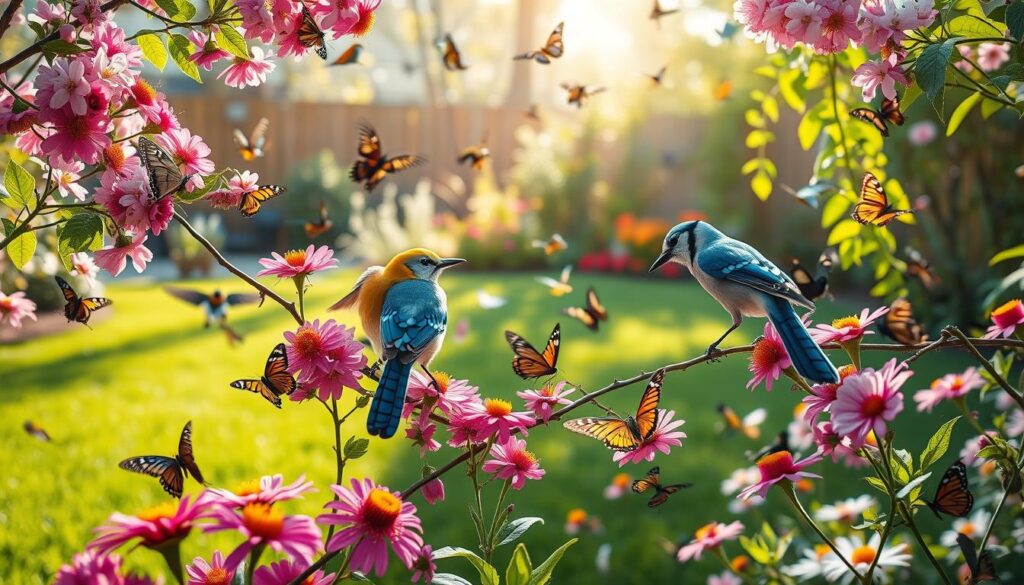
What Birds Eat Butterflies?
Birds come in many shapes and sizes, and some love to eat butterflies. They use different ways to catch their prey, like quick flying or sneaky hiding. These birds help keep butterfly numbers in check.
Warblers and Aerial Hunting
Warblers are known for their amazing flying and sharp eyes. They chase butterflies in the air, showing off their flying skills. Their fast moves and quick timing help them catch even the fastest butterflies.
Flycatcher Feeding Habits
Flycatchers are experts at catching insects in flight, including butterflies. They sit still, then quickly fly out to grab their prey. Their sharp eyes and fast reflexes make them great hunters, helping control butterfly numbers.
Ground-Feeding Birds
Robins and thrushes also eat butterflies, but they look for them on the ground. They search for insects and other food, including butterflies that rest or feed on plants. Their ground search adds to the variety of ways birds catch butterflies.
The way different birds eat butterflies is important for the balance of nature. It shows how all living things are connected.
| Bird Species | Feeding Habits | Butterfly Hunting Techniques |
|---|---|---|
| Warblers | Insectivorous | Aerial pursuit, capturing butterflies in mid-flight |
| Flycatchers | Insectivorous | Perch-and-pounce, ambushing butterflies in flight |
| Robins, Thrushes | Ground-feeding, omnivorous | Foraging on the ground, capturing butterflies resting or feeding on plants |
The relationship between birds and butterflies is complex and important. Each species has a role in keeping the ecosystem balanced. Learning about how birds eat butterflies helps us understand the beauty and complexity of nature.
Butterfly Defense Mechanisms Against Birds
Butterflies have developed many ways to protect themselves from birds, a big threat. These defenses help keep the balance in nature and control pests. They are key to the health of our ecosystems.
The Monarch butterfly is a great example. As caterpillars, they eat milkweed plants and get toxic compounds. This makes them taste bad to birds, keeping them safe. Their bright colors also warn birds of their toxicity.
The Viceroy butterfly uses mimicry to its advantage. It looks like the toxic Monarch, fooling birds into staying away. This clever trick helps the Viceroy and keeps the ecosystem in balance.
Butterflies also have physical defenses like hairs and spines. These make it hard for birds to catch and eat them. They offer extra protection, especially against small predators.
| Defense Mechanism | Example | Effectiveness |
|---|---|---|
| Chemical Toxicity | Monarch Butterfly | Highly Effective Against Birds |
| Mimicry | Viceroy Butterfly | Moderately Effective Against Birds |
| Physical Defenses | Hairs, Spines, Bristles | Effective Against Invertebrate Predators |
These butterfly defense mechanisms show how well they’ve adapted to survive. They play a crucial role in keeping our ecosystems healthy and balanced.
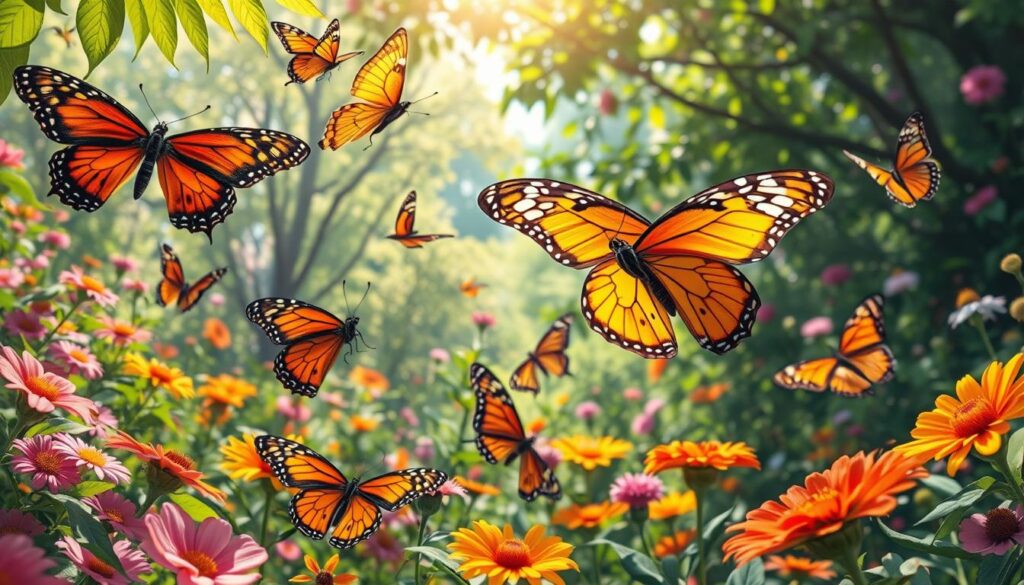
The Monarch Butterfly: A Special Case Study
The Monarch butterfly is a remarkable example of how nature protects a species from birds. As caterpillars, Monarchs eat milkweed plants. These plants have toxic compounds called cardenolides.
These compounds make Monarchs taste bad and possibly harmful to birds. This scares many birds away from eating them.
Toxicity and Bird Avoidance
The Monarch’s orange and black colors warn predators that they taste bad. This warning color, called aposematic coloration, works well to keep birds away. Birds, like cuckoos in New Zealand, won’t eat Monarch caterpillars or adults because of the toxins.
Migration Patterns and Predation
The Monarch’s long migration affects its battles with bird predators. Western monarchs have declined by more than 99 percent since the 1980s, while Eastern monarchs have declined by an estimated 80 percent. Groups are pushing to list the Monarch as endangered.
Climate change also hurts the Monarch’s life cycle and migration. Planting milkweed is key to helping Monarchs. Citizen science and awareness campaigns help too.
“Monarch butterflies use warning coloration and toxicity as self-defence mechanisms, making them less vulnerable to bird predation.”
The Monarch’s amazing adaptations and migrations fascinate many. By learning about their challenges, we can help protect these iconic creatures for the future.
Bird Feeding Behaviors and Techniques
Birds have many ways to catch butterflies. Some, like flycatchers, sit still and then quickly grab flying insects. Others, like warblers, chase butterflies in the air, showing off their flying skills.
Ground-feeding birds eat butterflies when they find them while looking for seeds or insects. This variety in hunting helps different birds find food in their own ways.
Studies show that bird numbers in the U.S. have dropped by almost a third since 1970. Feeding stations at places like Santa Ana National Wildlife Refuge in Texas are great for visitors. They offer food for birds on their way to and from their homes.
Bird feeding is getting more popular, with 59 million people doing it in 2020. But, we must think about how it affects birds and the dangers from predators like cats. Cats kill over 2.5 billion birds every year in the U.S. and Canada.
- Cleaning bird feeders every two weeks can lower disease risks for birds.
- Putting feeders close to windows or using decals can stop birds from hitting them.
- Clearing up old seeds can keep rodents and raccoons away from feeders.
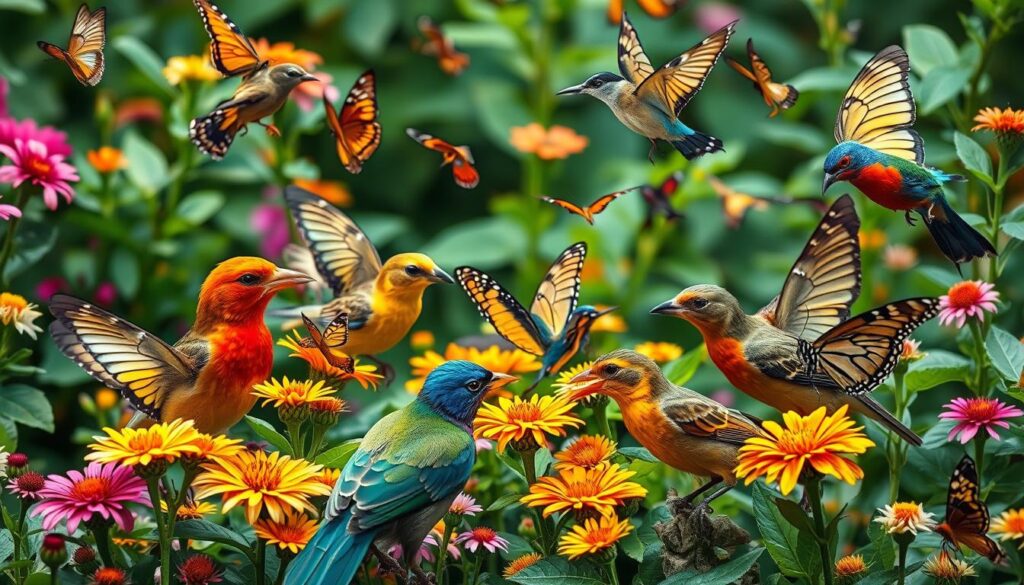
Learning about how birds hunt butterflies helps us see their special bond with their prey. It also shows us how to help and protect these birds.
Impact of Weather on Bird-Butterfly Interactions
The relationship between birds and butterflies is deeply affected by weather. Changes in seasons and temperature impact how many butterflies are around. This, in turn, changes how birds hunt and eat.
Seasonal Changes
With the seasons changing, so does the number of butterflies birds can find. In warmer months, butterflies are more active and easy to catch. But when it’s cold, they move slower and are easier for birds to eat.
Temperature Effects
Temperature plays a big role in how birds and butterflies interact. When it gets colder, birds might eat butterflies that are toxic to them. This is because they need more energy to stay warm.
These changes affect the balance of nature. They impact how people enjoy bird watching and nature observation.
“The effect of temperature preferences was more relevant in birds than in butterflies, highlighting the importance of considering the specific physiological and ecological traits of each taxonomic group when assessing the impact of climate change.”
| Weather Factor | Impact on Birds | Impact on Butterflies |
|---|---|---|
| Seasonal Changes | Altered foraging and predation patterns | Changes in abundance and activity levels |
| Temperature | Increased consumption of toxic prey, like monarch butterflies, to meet energetic demands | Reduced evasiveness and vulnerability to bird predation |
Garden Design for Bird and Butterfly Coexistence
Creating a garden for birds and butterflies is both fun and rewarding. Birds might eat butterflies, but this is part of a healthy ecosystem. With the right garden design, you can support both, making their coexistence possible.
Start by adding a variety of native flowers, shrubs, and trees. These plants feed butterflies and attract birds that eat insects. Place bird feeders and butterfly plants in different spots to balance their needs.
- Incorporate a mix of native plants that offer nectar, pollen, and host plants for butterflies.
- Provide bird feeders and birdbaths to attract a diverse range of avian visitors.
- Avoid using pesticides and opt for natural pest control methods to maintain a healthy garden ecosystem.
Designing your garden holistically lets birds and butterflies thrive together. This makes your garden beautiful and helps your local ecosystem.
| Garden Element | Benefit for Birds | Benefit for Butterflies |
|---|---|---|
| Native Flowers and Plants | Provide food sources (insects, seeds, berries) | Offer nectar and host plants for larvae |
| Bird Feeders and Baths | Ensure reliable sources of food and water | Attract birds that may prey on butterflies |
| Natural Pest Control | Support a balanced ecosystem with fewer chemicals | Maintain a healthy population of butterflies and their food sources |
Designing your garden for birds and butterflies creates a lively oasis. It celebrates the natural bond between these creatures.
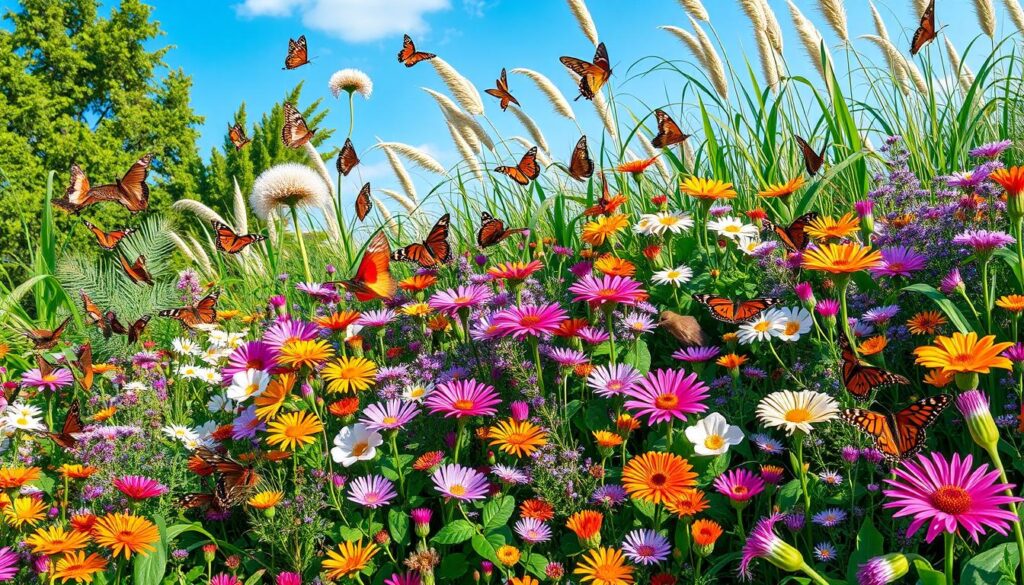
The Role of Birds in Butterfly Population Control
Birds are key to keeping ecosystems in balance by eating butterflies. This relationship is vital for natural pest control. It helps manage butterfly numbers and keeps the ecosystem stable.
Natural Balance
Insectivorous birds eat butterflies, preventing some species from getting too common. This natural action helps keep the ecosystem balanced. It stops any one species from taking over and upsetting the natural order.
Ecological Impact
Birds eating butterflies has big effects on the ecosystem. Butterflies are important for pollination, and losing them could harm plants. They also feed other animals, making birds’ control of them crucial for the ecosystem’s health.
| Bird Species | Butterfly Species Preyed Upon | Feeding Behavior |
|---|---|---|
| Warblers | Monarchs, Swallowtails | Aerial hunting |
| Flycatchers | Larger butterflies | Ambush from perches |
| Sparrows | Ground-dwelling butterfly species | Ground-feeding |
The relationship between birds and butterflies is complex and vital. It helps keep the ecosystem balance. By understanding this, we see how important natural pest control and insectivorous birds are to our ecosystems.
Butterfly Species Most Vulnerable to Bird Predation
Butterflies are often seen as delicate creatures. Yet, some species are more at risk from birds than others. Their size, how they fly, and their defenses play big roles in this.
Smaller butterflies, like skippers and blues, are often caught by birds. They are easy to grab because of their size. Butterflies that fly slowly or erratically are also more likely to be caught.
Butterflies without strong defenses are especially vulnerable. For example, the Monarch butterfly is toxic and safer from birds. But butterflies without these defenses are more likely to be eaten by birds.
“Beak marks indicating predator attacks on butterflies are a regular occurrence in nature, providing indirect evidence of predation intensity.”
Knowing which butterflies are most at risk is key for nature observation and conservation. By focusing on the most vulnerable species, we can protect more butterflies.
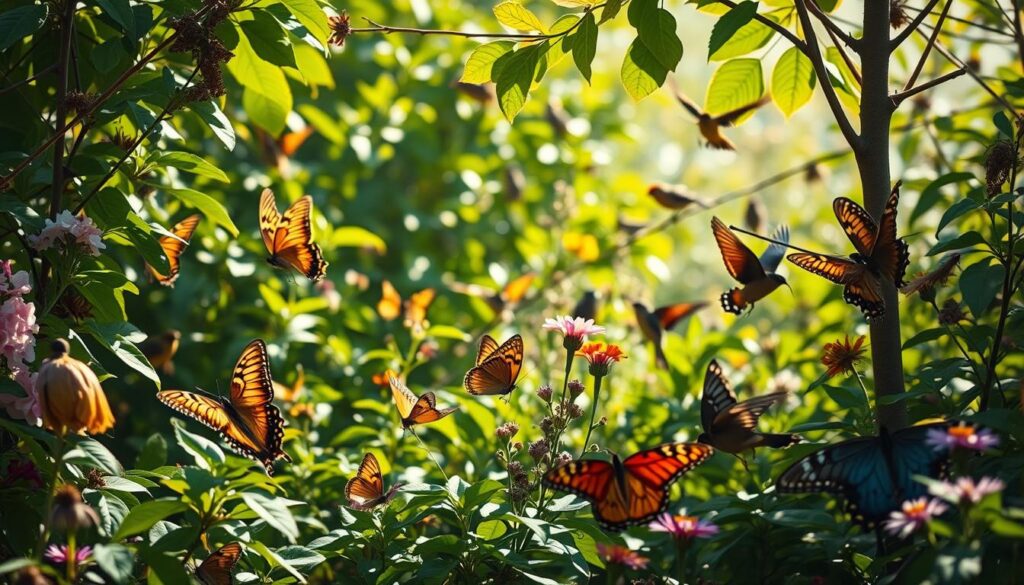
The relationship between butterflies and birds is complex. By studying these interactions, we learn more about our ecosystems. This knowledge helps us understand and protect these delicate creatures.
Birds’ Hunting Strategies for Catching Butterflies
Birds use many ways to catch butterflies. They chase them in the air or wait to ambush them. These methods help them get butterflies as food.
Aerial Pursuit Techniques
Swift birds like swallows and flycatchers are great at hunting in the air. They can quickly turn and catch butterflies. Their flying skills let them chase butterflies and catch them.
Ambush Methods
Some birds, like the eastern kingbird, wait patiently. They sit still until butterflies come close, then they grab them. Birds like the scarlet tanager also use this method to catch insects.
Ground-dwelling birds also hunt butterflies. Birds like bluebirds and nuthatches watch for butterflies on the ground. They use their sharp eyes to find and catch butterflies.
| Predator | Impact on Butterfly Population | Conservation Status |
|---|---|---|
| Praying Mantis | Moderate | Generally thriving |
| Spiders | Moderate | Thriving |
| Birds (American Robin) | Moderate | Thriving |
| Bats (Little Brown Bat) | Low | At risk due to White-nose Syndrome |
| Frogs (American Bullfrog) | Low | Thriving |
| Lizards (Common Anole) | Low | Thriving |
| Dragonflies (Common Hawker) | Moderate | Generally thriving |
| Ants (Red Imported Fire Ant) | Low | Invasive in many areas |
| Wasps (European Paper Wasp) | Low | Thriving |
| Snakes (Eastern Garter Snake) | Meager | Thriving |
Butterflies have ways to avoid birds, like looking like leaves or being toxic. But birds have many strategies to catch them. This helps them get butterflies as part of their diet.
The Viceroy-Monarch Mimicry Phenomenon
In the natural world, butterflies and birds have a fascinating dance. The Viceroy butterfly looks a lot like the Monarch. This trick, called Batesian mimicry, helps the Viceroy stay safe by looking like the Monarch, which is toxic to predators.
The Monarch butterfly is known for its bright orange wings and black veins. It gets its toxicity from eating milkweed plants as a larva. The Viceroy, though not toxic itself, looks like the Monarch. This makes birds think twice before eating it, just like they do with Monarchs.
This clever trick helps the Viceroy avoid being eaten. It shows how butterflies and birds depend on each other. This balance is key to the butterfly life cycle, nature observation, and ecosystem balance.
| Characteristic | Monarch Butterfly | Viceroy Butterfly |
|---|---|---|
| Body Shape | Similar in size and shape | Similar in size and shape |
| Wing Coloration | Vibrant orange with black veins | Orange with black veins and a narrow black band across each hind wing |
| Toxicity | Toxic due to milkweed diet | Non-toxic, though may be unpalatable |
| Feeding Habits | Larvae feed exclusively on milkweed | Larvae feed on a variety of plants, including willow, poplar, and cherry |
| Survival Strategy | Long-distance migration for survival | Hibernate during the winter |
The Viceroy-Monarch mimicry is a stunning example of nature’s complexity. It shows how important butterfly life cycle, nature observation, and ecosystem balance are.
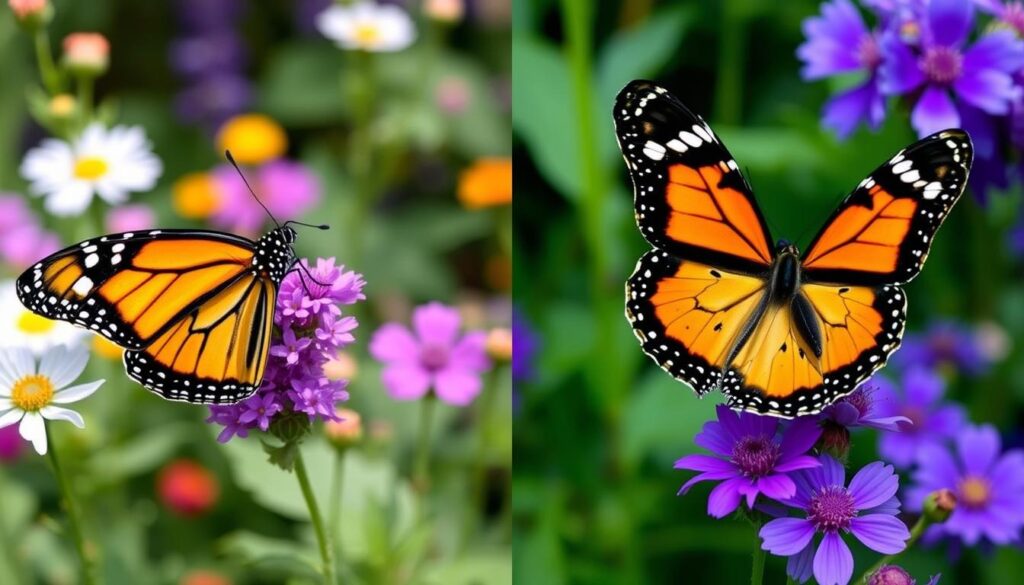
Scientific Research on Bird-Butterfly Relationships
Scientists have studied the complex bond between birds and butterflies deeply. They aim to understand how these creatures interact in nature. This research helps us see the balance in our ecosystems.
Dr. J. V. Z. Brower’s 1958 study suggested Monarch butterflies were safe from birds. But Bruce Petersen’s 1964 experiments challenged this idea. This shows how complex bird-butterfly interactions are and why we need more research.
| Study | Findings |
|---|---|
| Study on Eastern Kingbirds in the Adirondack Mountains | Butterflies made up 18% of their diet, with 42 out of 237 times they caught butterflies. |
| Comparative study in the Amazon rainforest | Only 3 out of 27 bird species hunted butterflies. |
| Research on Monarch butterfly defense mechanisms | 87% of birds avoided Monarchs after tasting them once. |
| Conservation efforts for the Miami Blue butterfly in Florida | A 23% increase in populations over the past three years. |
| Observations in the Sonoran Desert | More birds mean fewer butterfly infestations on native plants, helping control populations. |
Studies show birds have different ways to catch butterflies. Some, like Eastern Kingbirds, eat a lot of them. Others are more picky. Birds like swallows and flycatchers are great at chasing butterflies.
Butterflies have evolved to avoid birds. They look like other butterflies that are hard to catch. This shows how birds and butterflies have evolved together in nature.
More nature observation and research are needed. They help us understand how birds and butterflies keep our ecosystems healthy.
“Birds quickly learn to avoid flashy butterflies that have managed to evade them in the past and butterflies with a similar appearance.”
Conservation Implications for Both Species
Understanding how birds and butterflies interact is key for conservation. It’s vital to keep their habitats healthy for both. This helps keep the ecosystem balanced and supports natural pest control.
Creating butterfly gardens in cities and suburbs helps both birds and butterflies. These gardens offer food, shelter, and places to breed. They help keep species populations healthy by supporting their natural interactions.
“Strategic habitat conservation efforts benefit both birds and beneficial insects, contributing to ecosystem health and enhancing survival rates.”
It’s also important to protect grasslands, wetlands, forests, and coasts. These areas provide the resources and climates needed for birds and butterflies to survive and migrate.
Watching butterfly numbers can tell us a lot about the environment. Changes in butterfly populations can show us how healthy the ecosystem is. This helps us understand how to better protect birds, butterflies, and their homes.
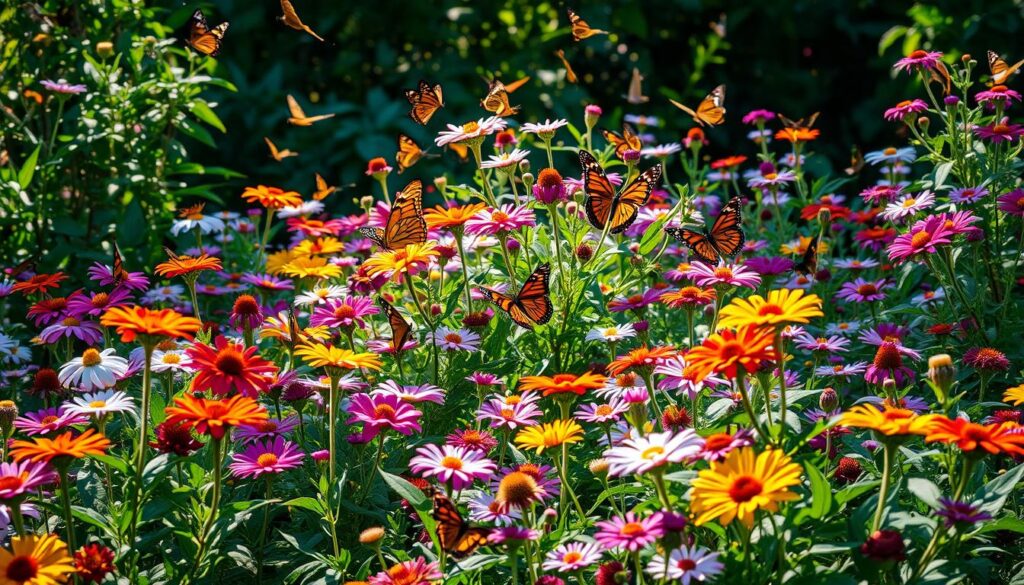
Protecting birds and butterflies is a big job, but it’s connected. By focusing on their habitats, we can help them thrive. This way, they can keep our ecosystems balanced and healthy for everyone.
Conclusion
The relationship between birds and butterflies is fascinating. Birds eat butterflies, but this is part of nature’s balance. Watching these interactions helps us understand our ecosystems better.
Knowing how birds and butterflies affect each other is key to saving nature. By studying them, we learn how to protect our planet. This shows us how all living things are connected and why we must live in harmony with nature.
This journey into bird-butterfly relationships teaches us to care for our planet. It shows us the importance of understanding nature’s balance. By doing so, we can make choices that help our world thrive. It reminds us of the beauty and complexity in nature.
FAQ
What birds eat butterflies?
Many bird species eat butterflies. These include warblers, sparrows, flycatchers, robins, thrushes, and wrens. They help keep the ecosystem balanced by controlling butterfly populations.
How does the predator-prey relationship between birds and butterflies contribute to ecosystem balance?
The relationship between birds and butterflies is key to a healthy ecosystem. Birds eating butterflies prevent any one species from getting too common. This keeps the ecosystem in balance, which is vital for biodiversity.
What are some common backyard birds known to eat butterflies?
Backyard birds like warblers, sparrows, flycatchers, robins, thrushes, and wrens eat butterflies. They use different ways to catch and eat them, helping to keep the ecosystem balanced.
How do different bird species hunt and consume butterflies?
Birds have many ways to catch butterflies. Warblers chase them in the air. Flycatchers sit and then swoop down. Ground birds like robins and thrushes eat butterflies they find while foraging.
What defense mechanisms do butterflies have against bird predation?
Butterflies have many ways to avoid being eaten by birds. Some, like Monarchs, are toxic to birds. Others, like the Viceroy, look like toxic species to scare off predators. These defenses help butterflies survive in the wild.
How does the Monarch butterfly’s toxicity and migration patterns affect its interactions with bird predators?
Monarch butterflies are toxic to many birds because of their diet. Their bright colors warn predators to stay away. Their long migrations also affect how birds interact with them in different places.
How do weather conditions impact the interactions between birds and butterflies?
Weather changes how birds and butterflies interact. Changes in seasons and temperature affect how active butterflies are. This, in turn, changes how birds hunt them.
How can gardeners support both birds and butterflies in their outdoor spaces?
Gardeners can help both birds and butterflies by creating a welcoming space. Planting native flowers and trees provides food and shelter. Placing bird feeders and butterfly plants in different spots helps keep a balance between the two species.
What are the conservation implications of understanding the relationship between birds and butterflies?
Knowing how birds and butterflies interact is key to conservation. Protecting their habitats is essential for maintaining a balanced ecosystem. Conservation efforts should focus on preserving these relationships and the biodiversity they support.
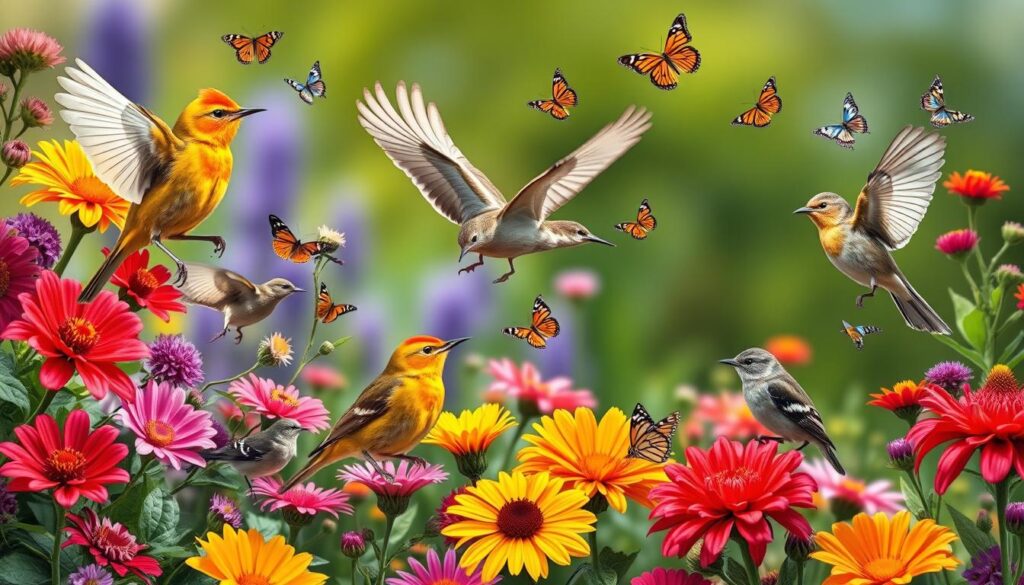

магазин аккаунтов https://birzha-akkauntov-online.ru/
купить аккаунт с прокачкой магазин аккаунтов
аккаунты с балансом заработок на аккаунтах
магазин аккаунтов продажа аккаунтов соцсетей
услуги по продаже аккаунтов маркетплейс аккаунтов
маркетплейс аккаунтов заработок на аккаунтах
магазин аккаунтов купить аккаунт
Profitable Account Sales Purchase Ready-Made Accounts
Database of Accounts for Sale Buy Account
Account Buying Service Online Account Store
Verified Accounts for Sale Account Trading Service
Secure Account Purchasing Platform Account Buying Service
Account Selling Service Profitable Account Sales
Account Sale Buy and Sell Accounts
Account marketplace Account Acquisition
Sell accounts Account Selling Service
accounts marketplace ready-made accounts for sale
marketplace for ready-made accounts account buying platform
account trading platform account trading platform
sell account find accounts for sale
buy account account marketplace
account buying service secure account sales
secure account sales sell accounts
account sale account selling platform
guaranteed accounts https://discountaccountsmarket.com/
account marketplace buy pre-made account
account store accounts market
After looking into a few of the blog posts on your web site, I truly like your way
of writing a blog. I added it to my bookmark website list and will be checking back soon. Please visit my website as well
and tell me how you feel.
My site – nordvpn coupons inspiresensation
secure account purchasing platform account selling service
account marketplace account catalog
account marketplace marketplace for ready-made accounts
account buying platform buy pre-made account
profitable account sales account buying service
account buying platform sell pre-made account
account purchase find accounts for sale
database of accounts for sale buy pre-made account
buy pre-made account account buying service
account market account trading
find accounts for sale website for selling accounts
account acquisition website for buying accounts
database of accounts for sale account acquisition
ready-made accounts for sale guaranteed accounts
social media account marketplace buy accounts
profitable account sales find accounts for sale
account trading platform account buying service
account selling service accounts marketplace
marketplace for ready-made accounts https://accounts-marketplace.xyz
account trading service https://buy-best-accounts.org/
account market https://social-accounts-marketplaces.live
verified accounts for sale https://accounts-marketplace.live/
buy account https://social-accounts-marketplace.xyz/
sell pre-made account https://buy-accounts.space
website for selling accounts accounts marketplace
account marketplace https://accounts-marketplace.art
social media account marketplace https://social-accounts-marketplace.live
buy and sell accounts https://buy-accounts.live
accounts for sale accounts marketplace
secure account purchasing platform https://accounts-marketplace-best.pro
покупка аккаунтов akkaunty-na-prodazhu.pro
продажа аккаунтов https://rynok-akkauntov.top
маркетплейс аккаунтов маркетплейсов аккаунтов
купить аккаунт akkaunt-magazin.online
покупка аккаунтов https://akkaunty-market.live/
маркетплейс аккаунтов соцсетей https://kupit-akkaunty-market.xyz
площадка для продажи аккаунтов https://akkaunty-optom.live/
маркетплейс аккаунтов соцсетей online-akkaunty-magazin.xyz
купить аккаунт https://akkaunty-dlya-prodazhi.pro/
продать аккаунт https://kupit-akkaunt.online
facebook ad account for sale https://buy-adsaccounts.work
buying fb accounts facebook ad account buy
buy facebook profile https://buy-ad-account.top/
buying fb accounts buy facebook advertising
facebook ads account buy https://ad-account-buy.top/
buy facebook account https://buy-ads-account.work
buying facebook account https://ad-account-for-sale.top
buy facebook advertising facebook account buy
buy aged facebook ads accounts https://ad-accounts-for-sale.work
buy google ads threshold account buy google ads agency account
google ads account buy https://buy-ads-accounts.click
buy fb ad account https://buy-accounts.click
google ads agency account buy ads-account-for-sale.top
buy google ads agency account https://ads-account-buy.work
buy aged google ads accounts https://buy-ads-invoice-account.top
google ads agency accounts https://buy-account-ads.work
buy google ads agency account https://buy-ads-agency-account.top
buy google ads accounts https://sell-ads-account.click